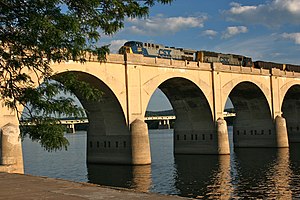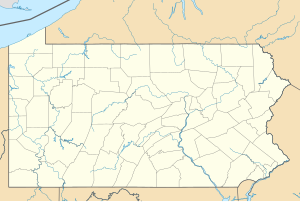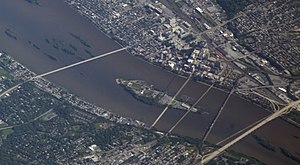Philadelphia and Reading Railroad Bridge (Susquehanna River)
Coordinates: 40 ° 14 ′ 57 ″ N , 76 ° 52 ′ 58 ″ W.
| Philadelphia and Reading Railroad Bridge | ||
|---|---|---|
| use | Railway bridge | |
| Crossing of | Susquehanna River | |
| place | Harrisburg and Lemoyne , Pennsylvania | |
| Entertained by | Norfolk Southern Railway | |
| construction | Arch bridge | |
| overall length | 1090 m (1924) | |
| width | 11 m | |
| Longest span | 23 m (between the central pillars) | |
| Clear height | 22 m (on the west bank) 14 m (on the east bank) |
|
| start of building | 1920 | |
| completion | 1924 | |
| location | ||
|
|
||
| Harrisburg with City Island on Susquehanna | ||
|
The bridges at the level of the river island from left to right: M. Harvey Taylor Memorial Bridge Walnut Street Bridge Market Street Bridge Cumberland Valley Railroad Bridge Philadelphia and Reading Railroad Bridge ( Dock Street Dam ) John Harris Bridge |
||
The Philadelphia and Reading Railroad Bridge is a double-track railway bridge over the Susquehanna River between Harrisburg and Lemoyne in the state of Pennsylvania in the USA . It is operated by the Norfolk Southern Railway and used for freight services on the route between Harrisburg and Hagerstown , Maryland .
The Philadelphia and Reading Railroad (later Reading Company ) replaced a truss bridge of the Philadelphia, Harrisburg and Pittsburgh Railroad from 1891 with the present concrete arch bridge by 1924 , whereby the old bridge piers were rebuilt and integrated into the new bridge. The bridge, which is more than a kilometer long, consists of 51 arches with a clearance of around 20 meters and extends into the urban area of Harrisburg.
In 1976 the bridge came together with the Reading Company and other bankrupt railway companies into the possession of the state rescue company Conrail and was finally taken over by the Norfolk Southern Railway in 1999 .
history
First truss bridge in 1891
In Harrisburg, the first bridge over the Susquehanna was built in the early 19th century on the site of today's Market Street Bridge . This led over the river island City Island , which is now surrounded by six bridges, including two railway bridges, with only the Philadelphia and Reading Railroad Bridge being used. Its predecessor structure was built between 1890 and 1891 by the Philadelphia, Harrisburg and Pittsburgh Railroad (PH&P), an amalgamation of several smaller railway companies that connected Harrisburg with Shippensburg , about 75 kilometers southwest . The PH&P was later acquired by the Philadelphia and Reading Railroad (P&R), which thus realized the connection of its rail network to the Western Maryland Railway in the southwest and strengthened its position in the competition with the Pennsylvania Railroad (PRR). The PRR controlled all railroad bridges over the Susquehanna in Pennsylvania below Selinsgrove , as well as the following upstream Cumberland Valley Railroad Bridge and Rockville Bridge .
In the immediate vicinity of the Philadelphia and Reading Railroad Bridge , upstream on the Lemoyne side, there are some bridge piers of an unfinished railway bridge on the South Pennsylvania Railroad , the construction of which was discontinued in 1885 as part of a compromise negotiated by the banker JP Morgan in the bitter power struggle of the major railway companies at the time.
Conversion to an arch bridge from 1920
The originally single-track bridge consisted of 23 wrought - iron lattice girders with a length of 45.5 meters each, whereby the sandstone pillars had already been laid out for a later double-track expansion. Since such an expansion never came about, the one-sided loading of the pillars led to their damage over time. With the advent of more powerful and therefore heavier steam locomotives at the beginning of the 20th century , the maximum load capacity of the bridge was also reached. P&R therefore decided to convert it to a double-track arched bridge made of reinforced concrete .
The bridge was rebuilt in the years 1920 to 1924. First, new concrete pillars were built between the original pillars, then the old ones made of sandstone were reinforced with a concrete casing and finally all pillars were connected by 46 arches made of reinforced concrete, one complete after the other Half of the bridge was built between the two banks. To ensure the ongoing operation of around 75 trains a day, the track on the old trusses was still used in the first phase of conversion. From July 1922, the first track was used on the first half of the arched bridge, which was newly built downstream, and construction of the second half continued.
A later extension of the bridge on the Harrisburg side increased the total number of arches to 51. The exact time of this extension is unknown. However, it took place no later than the 1940s, as shown by pictures from this decade .
Change of ownership in 1976 and 1999
As a result of the bankruptcy of several railway companies in the 1970s - including the successors of the P&R ( Reading Company ) and PRR ( Penn Central ) - the state rescue company Conrail was formed in 1976, which also owned the Susquehanna railway bridges. In 1999, Conrail was finally taken over by Norfolk Southern Railway and CSX Transportation . The Philadelphia and Reading Railroad Bridge went to the Norfolk Southern Railway , which it uses for its rail freight traffic between Harrisburg, Pennsylvania and Hagerstown , Maryland ( Lurgan Branch ), but also partially approves the use by CSX Transportation .
Construction work
The bridge reconstruction was carried out by the James McGraw Company from Philadelphia . Subcontractors for hydraulic engineering work on the base was TL Eyre , also of Philadelphia. In the first construction phase, the foundations of the old bridge piers were exposed using cofferdams and encased with 46 cm reinforced concrete, and new ones were built between the old piers. The river bed of the Susquehanna at a depth of one to three meters consists mainly of rock, on which the majority of the pillars rest. A concrete mixing plant on each side of the bank and an additional material web ( track width 610 mm) on cantilevers on the old lattice girders ensured the provision of concrete . The total amount of concrete transported and finally installed was about 67,300 m³.
The new pillars were initially raised to the level of the arch base ( fighting line ), the old pillars only on one side on the downstream side. Ten reusable formworks were used to erect the arches , the steel frame of which could be fastened in three specially made recesses per bridge pillar. The implementation of these falsework was carried out by means of lifting platforms mounted on pontoons . This made it possible to dispense with the erection of scaffolding structures in the river bed and to produce the 92 arch segments more quickly. The arches on the downstream side were built simultaneously from both banks towards the middle of the river. After the work was completed, rail traffic could be shifted from the trusses to this first half of the arched bridge and the material web for transporting concrete onto the trusses. This was followed by the completion of ten arches on the upstream side in the middle of the river, after which construction was continued towards the east bank and then from the center towards the west bank. The lattice girders could only be dismantled in stages, as the upper chords , supported by wooden structures, had to remain temporarily for the material web, but there was still enough free space for the falsework.
description
Complete overview

The part of the arch bridge, completed in 1924, consists of 45 arches with a span of just over 23 m and a final arch on the west bank (Lemoyne side) with 21.5 m (each measured from the center of the pillar). This is followed by a 21 m long girder bridge with solid wall girders to the abutment . The total length of the original bridge is around 1090 m. The bridge was later extended by five arches of a similar span on the east bank (Harrisburg side) and thus extended by about 100 m. The bridge has a gradient of 7 ‰ from the west to the east bank, which reduces the height of the track level above normal water level from 24 m to 17 m. The bridge was designed in such a way that a minimum clearance height of 8.7 m is guaranteed, based on the highest water level known at the time during flooding .
Pillars and arches

The concrete shell of the former sandstone pillars is 3.5 m wide at the arch base, the newly erected reinforced concrete pillars are 2.7 m wide. All pillars have a length of 15.8 m at the bottom edge of the foundation, above the edge protection this is only 10.7 m, which corresponds to the width of the superstructure. With spans of 23 m, there is a clear width at the arch base of around 20 m. The arches are designed as round arches with a radius of 10 m at the bottom and segment arches with a radius of 18 m at the top, the thickness of the arches thus tapers from the pillar to the top from around 3.3 m to 0.9 m. The spandrels form concrete walls up to the level of the track level, on which a 1.2 m high railing made of the same material is attached. The interiors of the chip grooves are filled with stone on which the tracks run. An additional vertical partition in the middle area was created during construction for the commissioning of the first 4.1 m wide bridge half and was left there.
facade
The facade of the bridge is kept simple. The side surface of the arches and spandrels are smooth without any decorations except for the joints between the arch segments cast from the outside to the inside. The pillars are set off above the edge protection by a protruding vertical reinforcement ( pilaster ), into which a large rectangular vertical recess is incorporated as a further element of the pseudo architecture . The railing downstream consists of closed walls, on the opposite side of two parallel steel pipes between a large number of smaller concrete pillars. It is visually separated from the superstructure on both sides by a continuous cornice . At the ends of the bridge there is the inscription THE READING above some pillars in the railing and the year of completion in the cornice below.
literature
- Edwin Chamberlain: The New Susquehanna River Bridge at Harrisburg, Pa. In: Railroad Gazette. Vol. 23, No. 7, 1891, pp. 108-109.
- Edwin Chamberlain: Philadelphia & Reading to Build 46-Arch Bridge. In: Railway Age. Vol. 69, No. 21, 1920, pp. 869-871.
- Erik V. Fasick: Harrisburg and the Susquehanna River. Images of America, 2015, ISBN 978-1-4671-2298-6 , pp. 15-32.
- Charles H. Hitchcock: Philadelphia & Reading Builds 46-Arch Bridge. In: Railway Age. Vol. 73, No. 23, 1922, pp. 1035-1038.
- Justin M. Spivey: Philadelphia & Reading Railroad, Susquehanna River Bridge. Historic American Engineering Record, HAER No. PA-523, Washington, DC 2001.
Web links
- Philadelphia & Reading Railroad, Susquehanna River Bridge, Spanning Susquehanna River, Harrisburg, PA. Historic American Engineering Record , HAER No. PA-523.
- Philadelphia and Reading Railroad Bridge. HistoricBridges.org
Individual evidence
- ^ Report of the Operations of the Philadelphia and Reading Railroad Company. Philadelphia & Reading Railroad Co., Philadelphia 1891, p. 15.
- ^ A b Edwin Chamberlain: The New Susquehanna River Bridge at Harrisburg, Pa. In: Railroad Gazette. Vol. 23, No. 7, 1891, pp. 108-109.
- ^ A b Justin M. Spivey: Philadelphia & Reading Railroad, Susquehanna River Bridge. Historic American Engineering Record, HAER No. PA-523, Washington, DC 2001, p. 2.
- ↑ Joseph R. Daughen, Peter Binzen: The Wreck of the Penn Central. Beard Books, 1999, ISBN 1-893122-08-5 , pp. 19-24.
- ^ A b c d e Justin M. Spivey: Philadelphia & Reading Railroad, Susquehanna River Bridge. Historic American Engineering Record, HAER No. PA-523, Washington, DC 2001, pp. 3 f.
- ^ A b c d e Edwin Chamberlain: Philadelphia & Reading to Build 46-Arch Bridge. In: Railway Age. Vol. 69, No. 21, 1920, pp. 869-871.
- ↑ Erik V. Fasick: Harrisburg and the Susquehanna River. Images of America, 2015, ISBN 978-1-4671-2298-6 , p. 71.
- ^ Pennsylvania Railroad Map. Pennsylvania Department of Transportation, January 2017. Retrieved December 11, 2017.
- ^ A b Charles H. Hitchcock: Philadelphia & Reading Builds 46-Arch Bridge. In: Railway Age. Vol. 73, No. 23, 1922, pp. 1035-1038.
- ^ Edwin Chamberlain: Philadelphia & Reading to Build 46-Arch Bridge. In: Railway Age. Vol. 69, No. 21, 1920, p. 870.
- ↑ Justin M. Spivey: Philadelphia & Reading Railroad, Susquehanna River Bridge. Historic American Engineering Record, HAER No. PA-523, Washington, DC 2001, p. 3.




